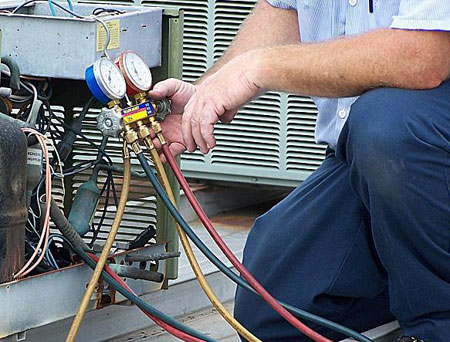The Most Effective Commercial Refrigeration Repair Companies in Toronto Revealed
The Most Effective Commercial Refrigeration Repair Companies in Toronto Revealed
Blog Article
The Ultimate Guide to Commercial Refrigeration Repair Work: Crucial Actions and Common Problems Described

Common Commercial Refrigeration Issues
When running industrial refrigeration systems, companies might encounter a number of common concerns that can impact the effectiveness and capability of the devices. Changing temperatures within the refrigeration device can lead to food perishing, boosted power consumption, and jeopardized high quality and security standards.
An additional common concern is refrigerant leakages. Leaks can result from deterioration, inadequate installation, or making defects. Low cooling agent degrees not only hinder the device's air conditioning ability but can additionally lead to compressor failing if left unaddressed.
In addition, ice build-up on evaporator coils is a frequent concern. Ice accumulation limits airflow, causing the device to function tougher and take in even more power. Routine cleaning and maintenance of the coils can assist avoid this concern.
Essential Tools for Repairing Refrigeration Devices
Utilizing the ideal devices is critical for properly repairing commercial refrigeration devices to guarantee ideal performance and longevity. Amongst the fundamental tools needed are manifold gauges for inspecting cooling agent pressures, refrigeration wrenches for tightening up or loosening up installations, a multimeter for testing electric parts, and leak detection tools such as digital leakage detectors or ultraviolet dye packages.
In the realm of specialized devices, tube cutters and flaring tools are essential for dealing with copper tubing, while a recuperation maker is necessary for securely removing refrigerants. A temperature gun can be useful for rapidly determining temperature level differentials within the system. Purchasing top notch tools not only improves effectiveness during repairs however also adds to the precision and reliability of the upkeep job carried out on industrial refrigeration units.
Step-by-Step Troubleshooting Guide

The next step is to test the temperature controls and settings to ensure they are operating appropriately. This includes inspecting the thermostat, defrost timer, and various other control devices to verify that they are regulating the temperature as intended. If any inconsistencies are found, substitutes or changes may be required. commercial refrigeration repair.
Subsequently, the specialist must take a look at the condenser and evaporator coils for dust or particles build-up, which can impede correct cooling. Cleansing these components can commonly solve problems with temperature level regulation and effectiveness.

Preventative Upkeep Strategies
Executing routine preventative upkeep procedures is necessary for making sure the longevity and ideal efficiency of industrial refrigeration systems. By sticking to a positive maintenance routine, organizations can lessen the risk of costly break downs, protect against downtime, and extend the life expectancy of their refrigeration devices.
One crucial preventative upkeep method is regular cleansing of condenser coils. With time, these coils can build up dirt, debris, and dust, which can hinder warmth transfer and lower the system's effectiveness. By cleaning up the coils regularly, services can ensure that the refrigeration system runs at peak performance.
In addition, inspecting and replacing used gaskets on doors is another vital upkeep task. Damaged gaskets can bring about air leaks, causing the refrigeration system to work harder to maintain the desired temperature. By replacing malfunctioning gaskets immediately, organizations can boost power performance and prolong the life of the equipment.
Incorporating these preventative upkeep methods right into moved here a comprehensive maintenance plan can assist companies optimize the performance and dependability of their industrial refrigeration systems.
Professional Fixing Vs. DIY: Pros and Cons
Involving an expert repair work solution for commercial refrigeration systems supplies distinctive advantages over trying DIY fixings. Industrial refrigeration units are complex systems that require specialized knowledge and abilities to diagnose and fix successfully. Specialists have the training and experience to identify issues properly, bring about quicker and extra precise repairs. They also have accessibility to sophisticated tools and equipment that may not be easily offered to the ordinary individual.
Moreover, expert fixing services typically give service warranties on their job, giving you assurance understanding click site that the task is ensured. Attempting to repair an industrial refrigeration system yourself can bring about further damages otherwise done correctly, possibly causing even more expensive fixings down the line. In addition, DIY repair services may nullify any type of existing guarantees on the equipment, leaving you exclusively accountable for any type of future problems that might occur. While do it yourself repair services may seem economical at first, the long-lasting benefits of professional fixing services exceed the risks and uncertainties related to attempting fixings by yourself.
Conclusion
In verdict, recognizing common industrial refrigeration problems, having the important devices for fixing, following a detailed troubleshooting overview, and applying preventative maintenance methods are essential elements of maintaining and repairing business refrigeration systems. While specialist repair services might supply experience and effectiveness, DIY repair services can also be a cost-effective alternative for those with the needed abilities and knowledge. Inevitably, routine maintenance and prompt repairs are necessary for guaranteeing the correct functioning of business refrigeration systems.
Recognizing the essential steps for industrial refrigeration repair and being able to determine common problems are critical abilities for any kind of service proprietor or upkeep employees. In this thorough overview, we will discover the essential actions and common problems in business refrigeration fixing, outfitting you with the understanding needed to deal with these difficulties efficiently.
Engaging about his an expert fixing solution for business refrigeration systems provides unique benefits over attempting DIY fixings. Trying to repair an industrial refrigeration system on your own can lead to more damage if not done correctly, possibly resulting in more pricey fixings down the line.In conclusion, comprehending typical commercial refrigeration concerns, having the essential devices for repair service, following a step-by-step troubleshooting overview, and executing preventative upkeep techniques are crucial parts of maintaining and repairing industrial refrigeration units.
Report this page